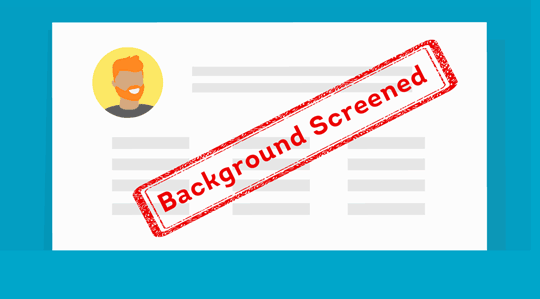Small business hiring timelines are important to follow as a owner to ensure you have all positions filled. Throughout the hiring timeline, you will need to complete certain tasks, such as identifying a hiring need, writing a job description, reviewing applications, conducting interviews, running background checks, and more. For a more in-depth look at each stage of the small business hiring timeline, keep reading below.
Remember that this material is intended to provide you with helpful information and is not to be relied upon to make decisions, nor is this material intended to be or construed as legal advice. You are encouraged to consult your legal counsel for advice on your specific business operations and responsibilities under applicable law. Trademarks used in this material are the property of their respective owners and no affiliation or endorsement is implied.
In comic books, zipping around at the speed of light is a superpower. But, when it comes to filling critical staffing shortages in your company, moving too fast can cause serious blows to your livelihood. Although many small businesses want to heroically fill vacant positions as quickly as possible, it takes time to arrange, manage, and run a successful search that results in an excellent hire.
While hiring timelines can vary by industry, position, and business, a Jobvite survey reflects that filling a vacant position takes about 37 days. Once you have your Super Candidate, it’s essential to protect yourself against potential villains. The best forcefield is comprehensive employee background screening through a reputable service like ShareAble for Hires.
The article below breaks down exactly what needs to be done during the 37 days, must-know details, and tips for using your time most efficiently.
Use this guide to review the details for each hiring stage or jump to our full-length infographic for a quick overview.
37-day Hiring Timeline for Small Businesses Outline:
- Day 1 - Identify your hiring needs
- Day 2 - Write job description
- Day 3 - Post job opening
- Days 4-14 - Receive applications
- Day 15 –Identify which applicants will advance in the hiring process
- Days 16-18 - Conduct phone interviews
- Day 19 - Identify which applicants will move on
- Days 20-27 - Conduct in-person interviews
- Days 28-29 - Choose a hire
- Day 30 - Extend a verbal offer and wait for feedback
- Day 31 - Conduct a reference check
- Day 32 - Extend a written offer
- Days 33-36 - Conduct a traditional background check
- Day 37+ - New hire begins onboarding and training
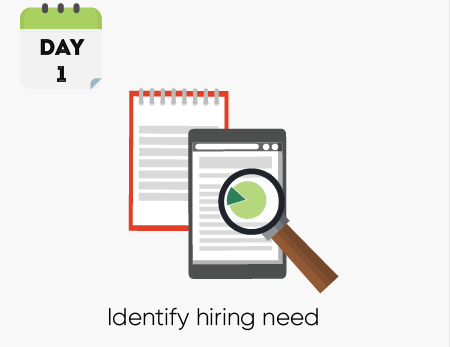
Day 1 – Identify Your Hiring Need
When it’s time to add a new member to your Super Squad, the first step it’s determining exactly what you need. Will this new person fill an existing, vacant position? If so, has the position changed at all since last time? Is it a new position? What are the exact responsibilities?
It’s important to ask yourself questions like these to determine whether hiring a new employee will benefit your company.
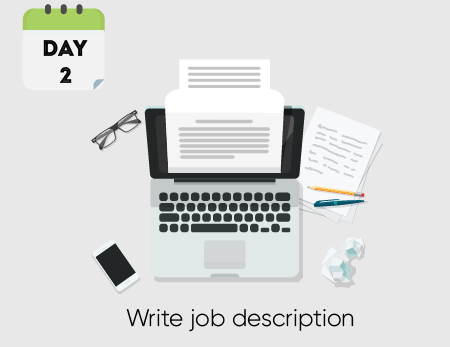
Day 2 - Write a Job Description
Once you’ve identified your needs, next comes writing a flawless job description that will attract top candidates. Often the first impression of your company, a good write-up includes who you are, what you do, details about the open position, and desired skills, credentials, or traits you want the ideal candidate to have.
Common mistakes when writing a job description include:
- Informal job titles: Candidates want to know they can advance at your company. Informal or non-existing job titles might send a message that growth isn’t possible. Try using professional, industry-consistent titles.
- Generic position and qualification descriptions: Be clear and specific about the role, duties, and qualities that are expected of the new employee. Include any degrees, certifications, or experience candidates need.
- Unrealistic responsibilities: Huge laundry-lists of duties and disproportionate pay are major turn-offs to job searchers. Consider if the duties are realistic for just one person and understand how your compensation compares to market averages.
- Insufficient company information:Your company shouldn’t be a mystery. Be clear about who and what you are, where you’re located, information on company culture, whether the position is in-person or remote, etc.
- Incomplete application information: Include how and where applicants should apply, key contacts, where to find additional information, and any application deadlines.
- Poor formatting: A job description represents your company. Make sure yours is organized, concise, and free from errors. Use sections and bullet points to make it easier to read.
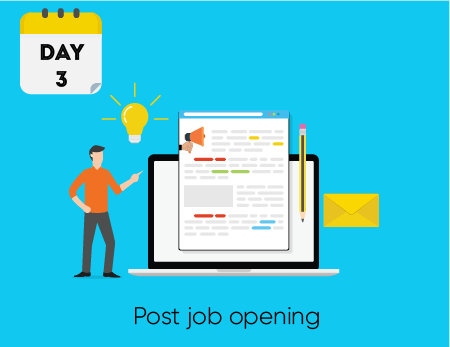
Day 3 - Post Job Opening
Once you’ve drafted a winning job announcement, it’s time to send it off. From web posting to stapling fliers to telephone poles, there are endless options for where to advertise jobs. Some are free, while others may cost hundreds of dollars.
When deciding where to post jobs, consider your specific industry and the location of the job. Some industries rely more on word of mouth or advertising through personal networks, while others benefit from highly personalized, niche websites.
Some options include:
- Advertising on online job sites, such as Indeed, LinkedIn, CareerBuilder, WeWorkRemotely, Glassdoor, or Craigslist.
- Sending it to personal social networks and asking for referrals
- Finding industry-specific job boards (virtual or physical)
- Community bulletin boards in places like public libraries (virtual or physical)
- Using a recruiter or recruitment service
- Putting an advertisement in a local paper or trade magazine
Some methods will result in lots of response quickly, while others may take time to distribute. By testing a few different places, you’ll likely find an advertising method that works best for your company.
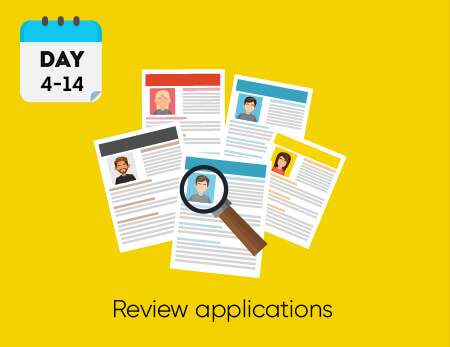
Days 4-14 - Receive Applications
After posting your irresistible job description, it generally takes 1-2 weeks to assemble a nice-sized candidate pool—and per Inc.com, the average job opening receives 250 applications, you’ll likely have a large group to choose from with time. Now it’s time to start reviewing job applications.
It can take a few days to get through them all. Some candidates will be easy enough to either disqualify or move on to the next round. Others may take additional review and considerations. To make the process easier and fair, consider creating a standardized resume review process.
Using scoresheets, rubrics or other systematic processes can help you look closely at candidate qualifications and even catch potential red flags—or even fraudulent applicants (more on that later).
Qualities hiring managers may want to look for:
- Strong work ethic
- Proven qualifications
- Relevant employment experience
- Previous growth within job, volunteer experience, or school clubs
- Demonstrated, authentic interest in your industry
- Self-motivation and thirst to learn
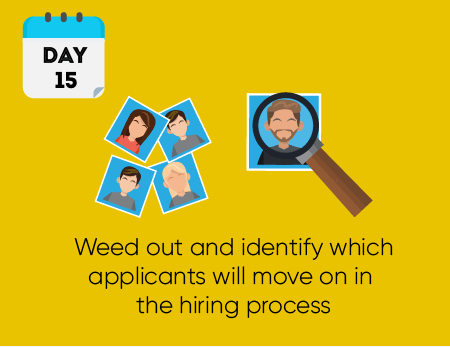
Day 15 – Identify Which Applicants Will Advance
Reading through candidate applications and reviewing resumes with a standardized rubric should help determine if someone has the right skill set, education, and experience for your position. This step helps narrow down your candidate pool, which saves time in the phone screening phase.

Days 16-18 - Conduct Phone Interviews
An applicant’s resume tells you about a candidate’s experience, while an initial interview provides a quick read on a candidate’s personality and professionalism. Once you’ve decided which applicants have potential on paper, reach out to request a phone or online interview.
Armed with a good list of questions, you can uncover a great deal of information in a short amount of time and determine if they’re worth advancement.
Keep the meeting relatively short (15-20 minutes)and take notes for later.Make sure to keep all interviews fair by sticking to the same questions and allow each candidate time to ask any questions they might have.
Tips on what to cover during an initial phone interview:
- Ask why the applicant is interested in the position
- Learn about relevant skills and previous work experience
- Answer applicant questions
- Confirm pay rate or salary information
- Communicate anticipated start date and hiring next steps
Keep records of which candidates meet your hiring requirements, as well as any outstanding qualities or red flags that may influence your decision.

Day 19 - Identify Which Applicants Will Move Forward
After you’ve interviewed all potential candidates, it’s time to tweak the hiring pool again. Compare your job description and notes from phone interviews and select which candidates you’d like to meet with in person.
How many candidates should you interview Hired recommends interviewing between 7-10 qualified candidates, but also clarifies that hiring managers should interview as many as they need to find the right person for the job.
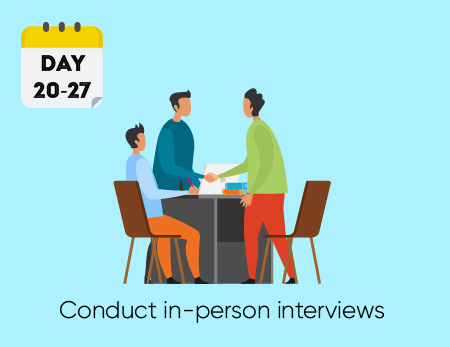
Days 20-27 - Conduct In-Person Interviews
In-person interviews are great opportunities to gauge professionalism and potential fit with company culture. However, they can, per Glassdoor, also be time-consuming.
Here are some time-saving tips for more efficient interviews:
- Start with the best. There’s no reason to save the best for last. Interviewing your top candidates first can help save time.
- Be organized and prepared. Use an interview scorecard to keep track of candidate responses. Provide the interview team with rubrics ahead of time and assign a specific area for each team-member to explore. Afterwards, meet as a group to discuss each candidate.
- Take notes. Keep track of candidate qualifications and any red flags that stand out. Keep in mind that, if a hiring lawsuit arises in the future, a candidate may have a legal right to see any interview notes.
- Panel interviews. If you’re meeting with a lot of prospects, consider streamlining the process with panel interviews rather than scheduling one-on-one meetings. With the help of co-interviewers, you can make a collective decision as to who would be the best fit.
- Keep it conversational. Instead of a “question-answer, question-answer” format, consider using a more natural, conversational flow. This lets the candidate know that you’re genuinely interested in their skills and how they will fit into the company. Maximize your time by focusing on the candidate, and then selling the company and position.

Days 28-29 - Choose a Hire
With the interviews over, it’s time determine your top candidate. However, making a final hiring decision isn’t always easy. CEO of Summit Leadership Advisors, Terri Tierney Clark advises (as reported in a SHRM blog) going “deeper than just seeing how many boxes they check off and weigh the importance of skills.” It’s useful to consider things like interview notes, scorecards, reference check results, and how the final candidates might fit into the culture of your organization.
Once you finally make your decision, there are still several important steps left to finish, which can take a few days to complete.
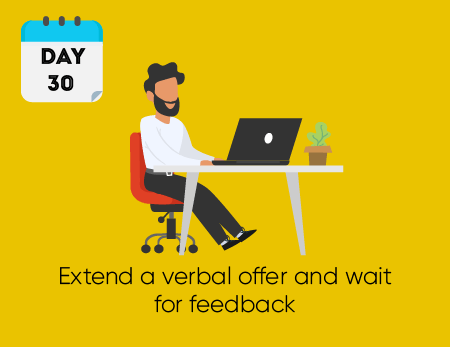
Day 30 - Extend a Verbal Offer and Wait for Feedback
Usually done over the phone, this conversation is your opportunity to offer the job to the candidate. Make it clear that the offer is contingent on a criminal background check for employment.
It’s customary, per CNBC, to give the candidate 2-3 days to consider the offer. Be prepared for them to need some time to think about it, ask for additional benefits or compensation, or even accept or decline on the spot.
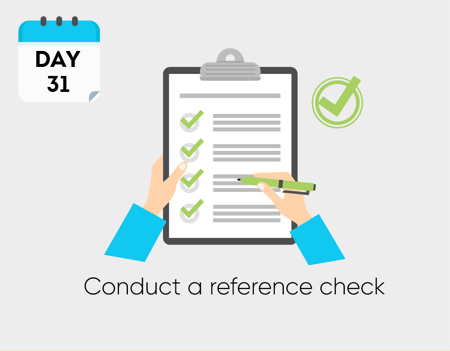
Day 31 - Conduct Reference Checks
If you haven’t already conducted reference checks to choose your finalist, now is the time to ask for a list of professional contacts. Per Glassdoor, when calling references to make sure to clearly explain the job opportunity so that the reference has enough context to answer questions specific to your company.
Additionally, consider asking about the candidate’s growth potential, memorable work successes or challenges, and whether the reference recommends the applicant for your open position.
Protect Yourself: Note that some candidates try to misrepresent previous experience or may even create fake references for job applications. It’s a good idea to verify the references are legitimate and the candidate’s work history is accurate with comprehensive pre-employment screening.
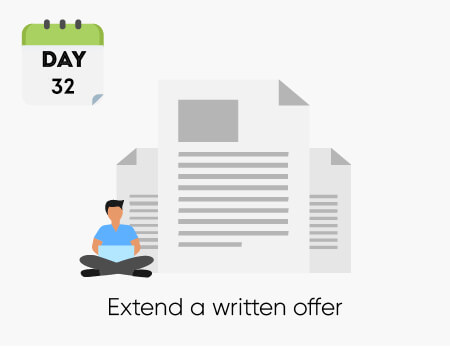
Day 32 - Extend a Written Offer
Assuming glowing reference checks, it’s time to provide a formal written offer. Offer letters should include at least the following:
- Any contingencies on the job offer—like a criminal background check
- Job description, compensation, benefits
- Company policies
- A statement of at-will employment
You can use a template or write your own letter. Either way, both you and the employee should sign this agreement.
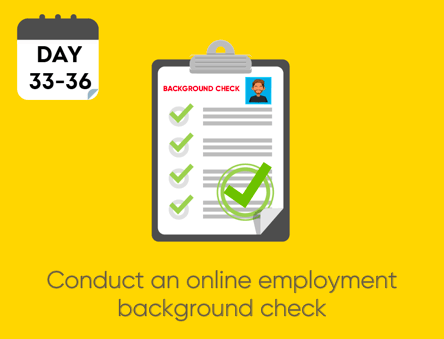
Days 33-36 - Conduct an Online Employment Background Check
Perhaps the most essential part of the hiring process, the final background screening is your last opportunity to thoroughly vet your candidate before letting them loose in your organization.
Don’t let your small business fall prey to professional scammers and fraudsters. It’s crucial to complete a lawful, comprehensive employee background check to protect your livelihood and help reduce the risk of hiring the wrong person.
Traditional vs. Online Background Checks
Traditional background checks can take several days—or even weeks—to complete. This leaves you with a vacant position for too long. Plus, running traditional background checks can be expensive for small business owners.
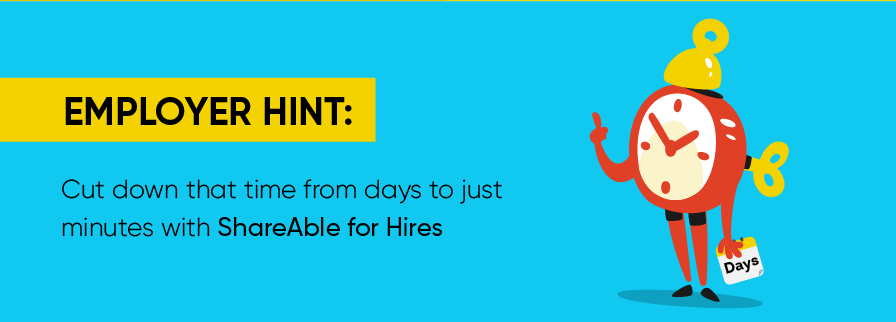
Unlike traditional background checks, a comprehensive, online screening service like ShareAble for Hires can provide you with reliable, accurate results in just minutes. The entire process can be done online and even from a mobile phone.
When choosing an online screening service, make sure the provider is FCRA-compliant. In addition to criminal background checks, verify if your provider offers credit check for employment if your new employee will be handling cash or personal data.
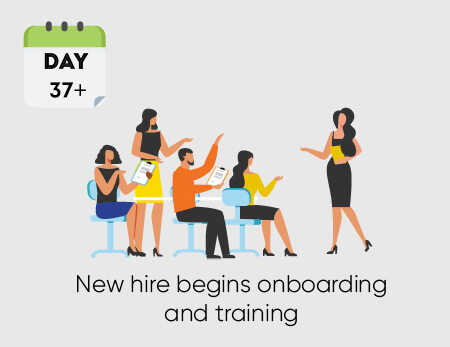
Day 37+ - New Hire Begins Onboarding and Training
Hooray! Your candidate passed their background check and formally accepted your offer. Get your new team member off to a great start with organized onboarding and training.
Some of benefits of comprehensive onboarding plans for new employees include:
- Increased retention
- Reduced employee turnover and associated costs
- Improved job satisfaction and confidence
- Increased employee engagement and commitment
- Eased job transition for both employee and employer
Stay organized by creating a standardized plan for onboarding new employees. Some good tips include having an orientation agenda, training checklist, and a 90-day follow up plan.
Infographic: Small Business Hiring Timeline

Share this Image On Your Site
Optimize Your Hiring Timeline with ShareAble for Hires
You don’t need x-ray vision to see that an entire hiring timeline can devour a large chunk of time. However, adding a new team member into the mix doesn’t have to mean a long, drawn-out battle. Make quick work of your hiring process with comprehensive employee screening with ShareAble for Hires.
While traditional background check companies can drag your hiring timeline out for days or even weeks, ShareAble for Hires provides ultra-reliable, completely online background checks fast—speeding train fast. Designed specifically for small businesses with only occasional screening needs, you can start screening any time, from anywhere with no lengthy signups, no waiting periods, and no required minimums or subscriptions. Simply create a free account to get started.
Help weed out potential wrong hires with on-demand criminal background checks, credit history, identification reports, and more. Backing by TransUnion—a major credit-reporting agency—means you can be rest-assured reports compliant with all federal consumer reporting regulations, including FCRA.
Choosing your champion might be arduous and difficult decision but screening them doesn’t have to be. Become a hiring hero. Assemble your strongest team yet with comprehensive employee screening through ShareAble for Hires.
You are legally required to verify employment authorization, and these requirements are enforced by the USCIS.

